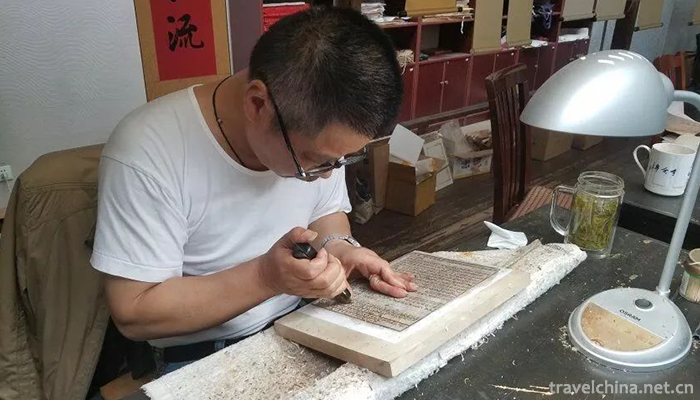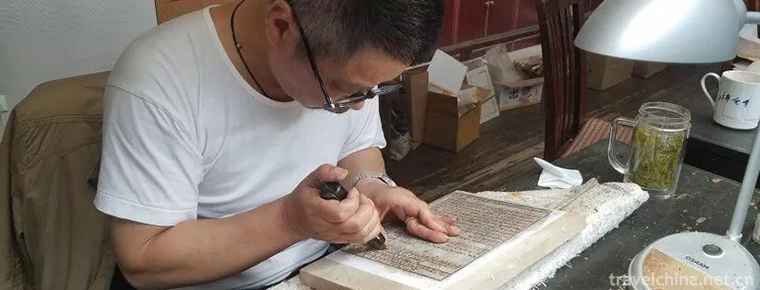Engraving Printing Skills
Engraving Printing Skills
Engraving printing technology, Yangzhou City, Jiangsu Province, local traditional handicraft, one of the national intangible cultural heritage.
Carving, catalpa line, engraving and so on are the skills of reverse engraving words and images on the board, then brushing ink on the board and laying paper under pressure, so that the pictures and text on the plate can be transferred to paper. This technique has higher aesthetic requirements in writing and design. The key of engraving is to control the speed and direction of the knife, especially the sticking, knitting and folding skills. The whole process exudes a simple and elegant cultural atmosphere.
On May 20, 2006, the woodblock printing technology was listed in the first batch of national intangible cultural heritage list by the State Council of the People's Republic of China. The number of the heritage is_-78.
historical origin
Engraving printing began in Sui Dynasty and went on in Tang Dynasty. Excellent in the Song Dynasty, prosperous in the Ming and Qing Dynasties. On this basis, Bi Sheng invented movable type printing in Song Dynasty, but block printing was not completely replaced by movable type printing, which still occupied an important position in ancient Chinese printing industry.
Printed objects in the Sui Dynasty have not yet been circulated. The earliest surviving printed matter is the "Draconian Sutra" unearthed from the tomb of the Tang Dynasty in Xi'an. The Diamond Sutra, produced in the Dunhuang Tibetan Sutra Cave, was engraved in 868 A.D. (the Ninth Year of Xiantong, Tang Dynasty). Yuan Zhen, a poet of the Tang Dynasty, wrote a preface to Bai Juyi's poems. He talked about Bai Juyi's poems being widely spread through "Mole". From the literature at that time, Yangzhou block printing flourished in Tang Dynasty.
During the Five Dynasties and Ten Kingdoms, the printing area expanded and the variety increased. The most prominent thing was that the government began to organize and print Confucian classics in Guozijian.
In the Song Dynasty, printing flourished in China. At that time, Yangzhou was at the forefront of the military confrontation between the north and the south, with constant wars and a lack of social environment for stereotyped books. The woodblock printing of Yangzhou in Song Dynasty was not commensurate with its status.
In the Yuan Dynasty, the economy and culture had not been restored, and the war started again, and the Yangzhou Engraving Society only continued sporadically.
In Ming Dynasty, with the gradual recovery of economy and culture, block printing also developed. By the middle and late Ming Dynasty, the official and private engraving industry had developed greatly. Shen Kuo's Mengxi Literary Talk, presided over by Professor Tang Xiunian of Yangzhou Prefecture School, became the ancestor of various publications of the book.
In the Qing Dynasty, the development of Yangzhou block printing was at its peak. Official engraving, square engraving and family engraving stand in great numbers, engraving work is spread all over the country, and the engraving industry is flourishing unprecedentedly in China.
Book Title area. The scale of Yangzhou official inscriptions in the Qing Dynasty was much larger than that of the previous dynasties. In the Qing Dynasty, a professional printing agency was set up to concentrate human and financial resources on printing. The successive establishment of Yangzhou Poetry Bureau, Yangzhou Bookstore and Huainan Bookstore and their brilliant achievements have also played a tremendous role in stimulating and promoting Yangzhou block printing.
In the Qing Dynasty, Yangzhou scriptures were engraved in the north of the Yangzhou River. The Buddhist scriptures were engraved in the brick bridge method of Jiangdu (founded in the fifth year of Tongzhi reign of the Qing Dynasty). They were carefully proofread and neatly engraved. They were sold at home and abroad. They were called "brick bridge engravings" in the academic circles. The number of printed scriptures is more than 1000 volumes.
In 1958, the carving artists scattered around Yangzhou concentrated in Yangzhou, engaged in the repair of stereotypes, and carved a part of the new version. In order to keep this ancient engraving process from being lost, Guangling Engraving Press was established in that year to undertake the collection, collection, collation and protection of ancient plates, and to organize and publish ancient books. Since 1962, more than 200,000 ancient editions of Jiangsu, Zhejiang and Anhui have been collected for unified renovation and protection. The Cultural Revolution was interrupted. In 1978, it was restored and renamed as Guangling Ancient Books Engraving Press of Jiangsu Province, and in 1999 it was renamed as Guangling Books Press.
Process characteristics
Wood with fine texture, uniform texture, easy processing and abundant resources must be selected for the materials used in engraving and printing. In order to obtain local materials, pear and jujube wood are mostly used in northern engraving, while poplar and catalpa wood are mostly used in southern engraving.
The ink used in engraving printing is also more distinctive, mostly using pine smoke and other raw materials, secret recipe preparation, so fragrance overflowing, never fade.
The tools used in engraving and printing are mainly carving knives and spade knives, which have various shapes and sizes. Carving different sizes of text and different parts of the text, we have to choose different carving knives.
Engraving printing technology has higher aesthetic requirements for writing and layout design. Engraving is the key technology to determine the quality and artistry of printing materials. It needs to control the speed and direction of knife movement, especially sticking, weaving and folding. The Guangling Ancient Books Engraving and Printing Agency in Yangzhou, China, still maintains a complete set of ancient books engraving and printing process, which has more than 20 processes. The whole process exudes a simple and elegant cultural atmosphere.
The inheritance mode of engraving printing technology can be divided into official carving, square carving and family carving according to the organizational form, and the inheritance characteristics are different. The inheritance of Yangzhou block printing technology can be divided into these three forms, but the inheritance is more orderly and the performance is more unique. Official inscriptions in Yangzhou are characterized by their high specifications, large scale, long duration, far-reaching influence and fruitful results. For the main purpose of making profits, the printer employs relatively stable engraving and printing artists to concentrate on engraving books in the bookstore, and gradually forms a unique style of engraving in a bookshop or a school of engraving in a certain area. Home-printed books account for the majority, and the most exquisite ones. Official engraving, square engraving and family engraving have played an important role in the dissemination and inheritance of Yangzhou engraving and printing technology, and also provided a broad space for the inheritance of engraving and printing technology.


-
1.Dameisha Beach Park
Dameisha Beach Park was built on June 18, 1999 with a total investment of 120 million yuan
Time 2018-10-12 -
2.Mount Maoshan
Maoshan is located in Jurong City, Zhenjiang City, Jiangsu Province. It is about 10 kilometers long from north to south, 5 kilometers wide from east to west, and covers an area of more than 50 square
Time 2018-12-06 -
3.Shanghai Wildlife Park
Shanghai Wildlife Park, located at 178 Nanliu Highway, Pudong New Area, Shanghai, is the first National Wildlife Park in China built by the Shanghai Municipal People's Government and the State Forestr
Time 2018-12-19 -
4.Cangyan Mountain Scenic Area
Cangyan Mountain, located 50 kilometers southwest of Shijiazhuang City, Hebei Province, is located in Jinglong County. As the core scenic spot of Cangyan Mountain, Cangyan Mountain Fuqing Temple is li
Time 2019-01-04 -
5.Thrush valley ecological tourist area
Thrushcross Valley is a natural eco-tourism area, located in Yaoshan Town, Lushan County, Henan Province, and at the northern foot of Yaoshan Scenic Area. It is a national AAAA-level tourist attractio
Time 2019-01-17 -
6.Weishan Lake National Wetland Park
Weishan Lake National Wetland Park, located in the southern part of Weishan County, Jining City, Shandong Province, is less than 3 kilometers away from the urban area.
Time 2019-02-22 -
7.White vinegar egg
Cuisine and efficacy: Heart-regulating diet, insomnia diet, palpitation diet, brain-tonifying diet
Time 2019-03-24 -
8.kylin dance
Kirin dance, also known as "Wu" Kirin, is a court dance performance of the Ming Dynasty in China. It was spread among the people when the Nanming Dynasty perished. When dancing,
Time 2019-06-10 -
9.An Lushan
An Lushan (703 to 757 years). Yingzhou (today's Liaoning Chaoyang) Kang Name Rolling hill 。 His father may be kang Hu people Mother A Stead S is a the turks Witch. According to legend, his mother did
Time 2019-09-11 -
10.Sugar Eggs
Laozao is a local snack, belonging to Sichuan cuisine. Laolao, a kind of wine brewing in ancient Chinese, is a Sichuan dialect, that is, boiled eggs with wine brewing. Put the mash in the pot and boil
Time 2020-03-09 -
11.Cultural and cultural undertakings in Suining
By the end of 2019, there are 7 art performance groups, 6 art performance venues (including private), 6 cultural centers, 105 cultural stations and 6 Public Libraries in Suining City's cultural system. There are 1 national cultural industry demonstration base
Time 2020-12-16 -
12.Life of Suining residents
In 2019, the per capita disposable income of Suining residents was 24865 yuan, an increase of 9.6% over the previous year. The per capita disposable income of urban residents was 34854 yuan, an increase of 3024 yuan over the previous year and an
Time 2020-12-16